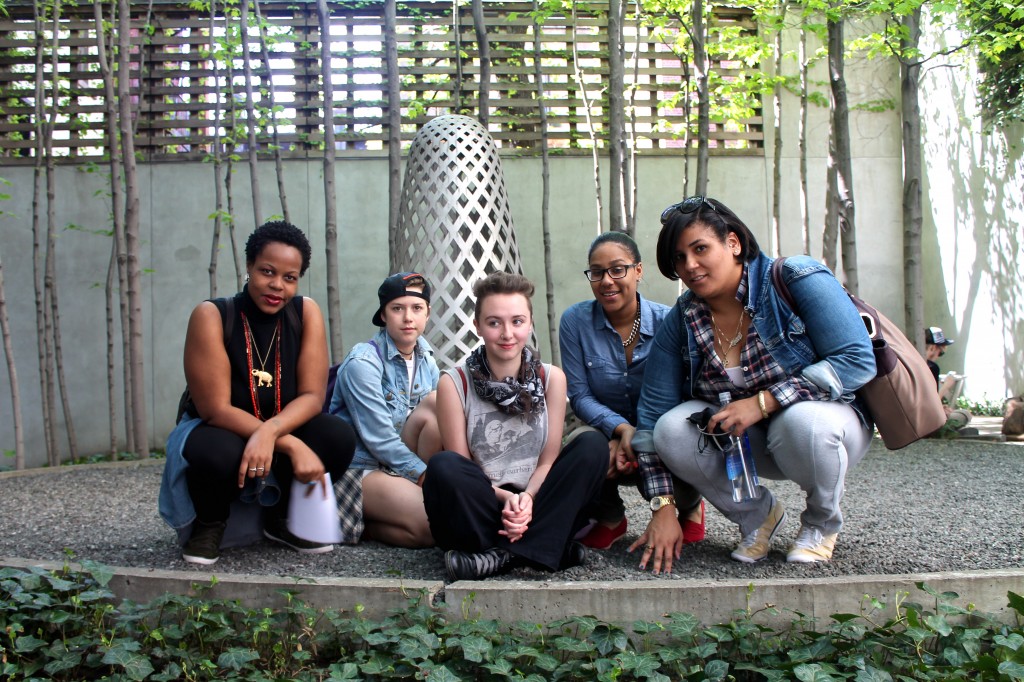
Around two in the afternoon on Wednesday, the beats of a drum echoed throughout the typically quiet halls of the 11th and 12th street Eugene Lang buildings. The rhythm picked up, died down for a few minutes, only to pick up again as the musician moved from classroom to classroom, interrupting several class sessions. The drummer was escorted by a handful of Lang students, some with their faces painted white, each of whom share a strong conviction that the lack of racial diversity is an issue that needs to be addressed by the administration of the college.
The group distributed handouts to students and faculty explaining their beliefs, and posted them on the buildings’ walls. Racial diversity “does not mean the minimal inclusion of students and faculty of color into a majority white university,” the handout read, and the group is concerned that “many students at Lang are currently ill-equipped to critically talk about race due to this passive white-washing of our course materials.”
Two of the organizers, Muggs Fogarty and Moremi Akinde, said that Lang doesn’t encourage discussions about race in the classroom and falsely advertises itself as a safe and engaging environment for people of color.
One example on the handout of such advertising cited the large presence of images showing students of color on the New School’s website homepage.
“I feel like it is exploitative and misleading at best,” said Akinde.
“So students of color at Lang made a small group to develop a performative action around that,” Fogarty said. They began by creating a Facebook page on April 25, announcing their plan to take action the following week.
On May 1, they kept to their plan and delivered their message to classes in session. A few professors asked them to leave, but others, like Professor Sara Villa who was teaching her course on Hispanic culture through film, decided to let them have their say.
Initially puzzled by the musical entrance, having never experienced such a protest in her career, Villa ended up feeling that there should be more protests of this kind. As to whether she believed whitewashing is a problem at The New School, Villa said, “I know it is, but I also know that the school is working on changing its image and is strongly committed to create more awareness among its faculty,” adding, “It’s just not happening fast enough.”
Lang freshman Sandra Menendez was one of the students in the classroom. Her initial reaction was similar to Villa’s. “I was kind of scared, surprised. [The performance protest] was unexpected. But when I read it, I thought it was creative. It was effective. It got people’s attention.” As to their message, Menendez said she does not feel judged as a person of color at The New School, which she believes to be very diverse, and that she feels “honored to go here.”
Akinda and her fellow protesters also mentioned the importance of curricular and faculty diversity in creating a safe environment for people of color. According to The New School Fact Book of Fall 2012, 37% of the undergraduate students across all divisions are white, making it the largest ethnic group at the university. 5% of undergraduate students are African American, 11% are Asian, and 11% are Hispanic or Latino.
Akinda and her fellow protesters also mentioned the importance of curricular and faculty diversity in creating a safe environment for people of color. After the protest, activists discussed the lack of diversity in the reading lists of required classes for Lang students.
“I think everyone at this school should be required to read Peggy McIntosh’s “Unpacking the Invisible Knapsack of White Privilege.” It should be a requirement, absolutely,” said Akinde, referring to an essay published in 1989. The protesters also mentioned the importance of having professors of color teach such material and other courses on the issue.
During the interview with Akinde and Fogarty in the Lang courtyard, Lang Professor Julie Napolin approached Akinde to ask questions and share her opinion.
“I think that faculty at all institutions could benefit from a pedagogy workshop on how to ‘teach race,’ not as a special category or course, but as a thread of discourse woven into all discussions,” Napolin said in an email response to questions sent by the Free Press after the confrontation.
The protesters also stopped by Dean of Eugene Lang College Stephanie Browner’s office to hand her their statement personally.
“I looked, I thought, I read the banner, I read the statement I was handed,” said Browner, speaking of her reaction to the protest. “All of it made me think. The white-face and banner and thoughtful statement worked together in compelling ways. I am a teacher and scholar of African American literature, and a dancer. Using space, words, costume in ways that make us think is something I find valuable.”







Leave a Reply